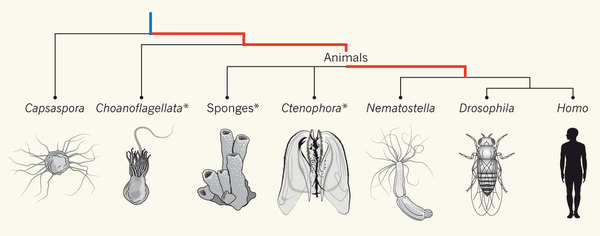|
|||||||||||||||
|

CLICK ON weeks 0 - 40 and follow along every 2 weeks of fetal development
|
||||||||||||||||||||||||||||
Short jump from single-cell to multi-cell animals Our single-celled ancestors lived about 800 million years ago. Now, new evidence suggests their leap to multi-celled organisms was not quite as mysterious as once believed. In a Developmental Cell paper publishing October 13, 2016, researchers demonstrate how our single-celled ancestors likely had molecular mechanisms used in cells today. Way back when — these assisted development into different cell types and then into tissue types.
Researchers studied a single-celled amoeba called Capsaspora owczarzaki. Originally discovered living inside a freshwater snail, it has been studied by Ruiz-Trillo's group to learn more about animal evolution. His team sequenced the Capsaspora genome in an earlier project and discovered that the amoeba contained many genes, that in animals, relate to multicellular functions. As a single-celled organism, Capsaspora doesn't have multiple cell types — as humans do. But, Capsaspora does change its cell type over time, from a single amoeba into a colony of cells in a cyst formation in its life cycle. The cyst is an aggregate of different Capsapora joining together, perhaps to survive desperate evironmental conditions, such as drought. Previously free-living, single cells gathered together do not have to be genetically identical.
In collaboration with the team of Eduard Sabidó at the Proteomics Unit of the Centre for Genomic Regulation and Universitat Pompeu Fabra, the group analyzed proteins in Capsaspora to determine its internal cell processes at different life stages.
Capsaspora owczarzaki can differentiate into two different cell types, (1) a cell type with filopodia-like structures; and (2) a naked, cyst form. Researchers discovered that from one stage to another, Capsaspora's suite of proteins use many of the same tools as multicellular animals to regulate change.
The presence of these protein-regulating tools in both Capsaspora and animals means that the single-celled ancestor of all animals likely also possessed these systems — and was more complex than scientists have previously given it credit for. "The ancestor already had the tools that the cell needed to differentiate into different tissues," says Sabidó. "The cells that were around before animals were more or less prepared for this leap." Abstract Highlights This work was supported by the European Research Council, the Spanish Ministry of Economy and Competitiveness, the Qatar National Research Fund, the European Union, the Institució Catalana de Recerca i Estudis Avançats, and the Secretaria d'Universitats i Recerca del Departament d'Economia i Coneixement de la Generalitat de Catalunya. Developmental Cell (@Dev_Cell), published by Cell Press, is a bimonthly, cross-disciplinary journal that brings together the fields of cell biology and developmental biology. Articles provide new biological insight of cell proliferation, intracellular targeting, cell polarity, membrane traffic, cell migration, stem cell biology, chromatin regulation and function, differentiation, morphogenesis and biomechanics, and regeneration and cellular homeostasis. Visit: http://www.cell.com/developmental-cell. To receive Cell Press media alerts, contact press@cell.com. Related articles:From Brief Encounters to Lifelong Unions Could the transient aggregation of unicellular organisms have paved the way for the evolution of the multicellular animals? Insights into the Origin of Metazoan Filopodia and Microvilli Our findings suggest that proteins essential for metazoan filopodia and microvilli are functionally conserved in unicellular and colonial holozoans and that the last common ancestor of metazoans bore a complex and specific filopodial machinery. |
Oct 21, 2016 Fetal Timeline Maternal Timeline News News Archive
Cyst phase of our ancient relative the single cell amoeba called Capsaspora owczarzaki.
|
||||||||||||||||||||||||||||



